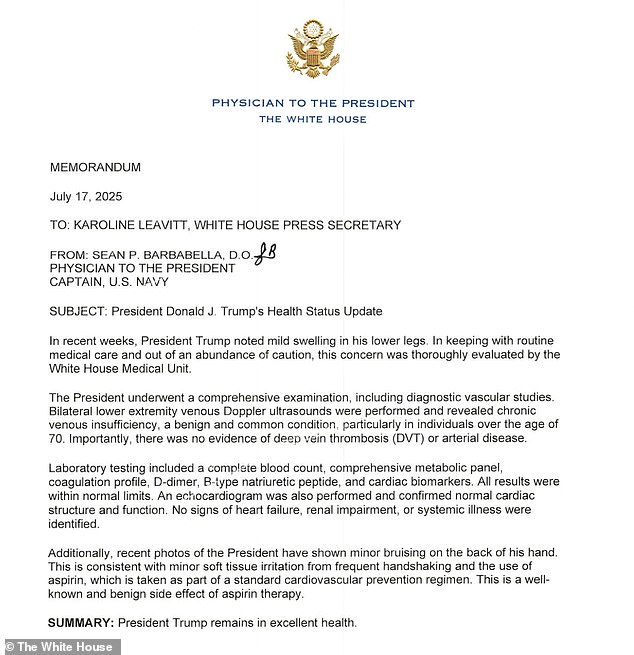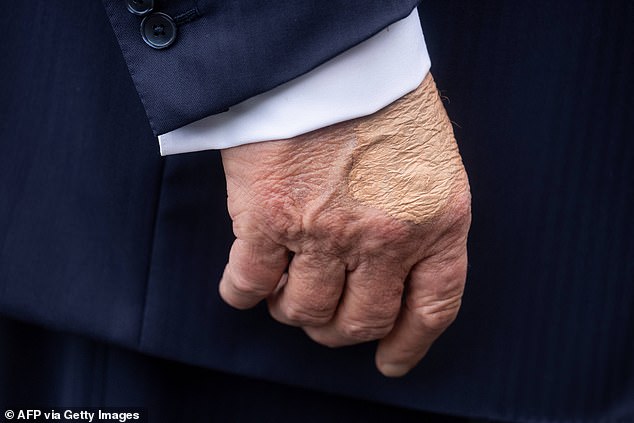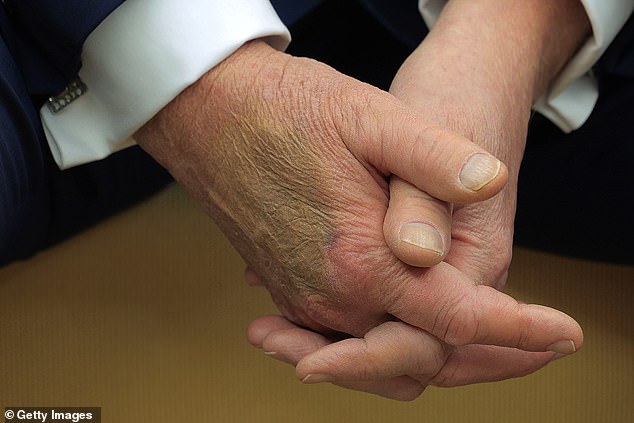The leader of the free world will no longer be able to regularly indulge in his favorite food following his new health diagnosis, according to medical experts who advise lifestyle changes for those who share his condition.
President Donald Trump is known for his love of McDonald’s and other fast food – a cuisine he even made part of his reelection campaign when he got behind the fryer at a Pennsylvania franchise.
But now Trump must think twice before gorging on a Big Mac, after the White House revealed he has been diagnosed with ‘chronic venous insufficiency’ – where blood flow in the leg veins is impaired, leading to swelling and other symptoms.
‘The McDonald’s has to go,’ Dr. Mahsa Tehrani, a Northern Virginia-based rheumatologist told the Daily Mail.
‘President Trump has expressed a liking for certain types of fast food restaurants. My recommendation as a physician is to limit fast food consumption because the sodium content in fast food can worsen the swelling in the legs,’ she added.
But she said Trump’s disease is manageable. ‘This not a big deal at all. This has nothing to do with life expectancy. As you get older, unfortunately, this stuff happens,’ she said, while sharing other recommendations that goes along with the diagnosis.
Trump, a frequent flyer on Air Force One, should also consider using compression stockings and elevating his legs.

Pass on the salt: Doctors and leading medical institutions advise people with Trump’s vein condition to consider a low salt diet and exercise
‘He needs to wear compression socks that help push this fluid back up again towards the heart,’ she said.
The stockings could also help when Trump is standing for long periods of time – as he does regularly during press statements, rallies and speeches, which routinely run an hour or longer.
‘If he’s going to be standing for a long period of time – because remember, as you’re standing, remember those [vein] valves aren’t allowing, they’re lazy, they’re sluggish, so they don’t allow the fluid to come back up to the heart again – Trump should use compression stockings.

Dr. Mahsa Tehrani tells the Daily Mail President Trump should avoid fast food to reduce water retention given his diagnosis
Trump is a regular weekend golfer at his private clubs in Florida and New Jersey, but he is not known to have a daily exercise routine. There is no reason why he shouldn’t be able to keep hitting the links. Trump rides in a golf cart when playing the links.
According to one National Institutes of Health publication, there are several strategies to manage the condition. These include ‘conservative therapies’ like ‘compression, elevation, and exercise,’ along with drug treatments. There are also more invasive treatments including ‘sclerotherapy, endovenous laser or radiofrequency ablation, or surgical ligation.’
Without proper management, there can be uncomfortable outcomes. ‘Delayed treatment can result in a more rapid disease progression, leading to complications including venous ulcers, infection, and deep vein thrombosis.’
The Cleveland Clinic advises people with the condition to avoid smoking – Trump doesn’t smoke – and avoid ‘restrictive clothing like tight girdles or belts’.
‘Don’t sit or stand for too long at a time. Get up and move around as often as you can,’ it advises.
‘Eat a heart-healthy diet. This includes reducing your sodium (salt) intake. Exercise regularly. Keep a healthy weight.’
By cutting down on salt – which provides some of the pep for Big Macs and McDonald’s fries, along with other Trump favorites like pizza – people are able to reduce water retention, which can limit blood flow from the veins to the heart.
Tehrani also told Fox News that hydration, walking, 30 minutes of daily exercise, and a heart-healthy diet could help.


Trump famously worked a McDonald’s fryer during the campaign. Now he might want to avoid salt to reduce swelling in his ankles

White House press secretary Karoline Leavitt says that Trump has been diagnosed with ‘chronic venous insufficiency’

A photograph of Trump Sunday at a Club World Cup soccer match drew numerous comments about his ankles, which appeared swollen
White House Press Secretary Karoline Leavitt told reporters that Trump was not experiencing discomfort after breaking the news to reporters about the diagnosis.
‘And you probably all see that on a day-to-day basis, he’s working around the clock. As for the treatment, I can defer to the President’s physician,’ was all she would reveal.
The letter released by White House Physician Sean Barbarella, DO, references ‘mild swelling’ in Trump’s lower legs, and states the diagnosis emerged after a series of vascular studies.
The White House disclosed Thursday that Donald Trump has a chronic condition that leads to swelling in his ankles and finally addressed mysterious bruising and makeup that has appeared on the president’s hand.
In a surprise statement from the podium during a press briefing, Leavitt told reporters the president was checked out by his doctor after noticeable ‘swelling’ and revealed that Trump has been diagnosed with ‘chronic venous insufficiency.’
Earlier this week, Trump, 79, appeared at a White House press gaggle with what looked like makeup covering a patch on the back of his hand sparking concerns. The splotch has been visible on other occasions throughout the week, sparking a new round of questions about the cause.
The makeup appeared to be concealing a raised circular area of skin.
Leavitt said during her rare medical update the president recently ‘noticed mild swelling in the lower legs’ and ‘in keeping with routine medical care and out of the abundance of caution’ he was evaluated by the White House medical unit.
He underwent a ‘comprehensive examination’ which included ‘diagnostic vascular studies.’
‘Bilateral, lower extremity ultrasounds were performed and revealed chronic venous insufficiency,’ Leavitt stated.
She said it’s a ‘common condition’ in individuals over the age of 70 and there was ‘no evidence’ of deep vein thrombosis or arterial disease.
She also addressed the ‘minor bruising’ on the back of Trump’s hand.
‘This is consistent with minor soft-tissue irritation from frequent handshaking and use of aspirin, which is taken as part of a standard cardiovascular prevention regimen. This is a well-known and benign side effect of aspirin therapy.’
‘The president remains in excellent health,’ Leavitt continued.
‘Importantly, there was no evidence of deep vein thrombosis or arterial disease,’ she added.
Leavitt said in response to a question that there was ‘no discomfort from the President at all.’
She then pointed to his daily activities. ‘And you probably all see that on a day-to-day basis, he’s working around the clock. As for the treatment, I can defer to the president’s physician,’ she said.
Neither Leavitt nor the letter addressed whether Trump would have to modify any of his routines – which include frequent golfing at his private courses on weekends, and his trademark dance moves to ‘Y.M.C.A.’ when he addresses rally crowds.
Officials have previously mentioned Trump’s frequent handshaking – Trump regularly interacts with a large number of people at White House events and when he travels – as the cause of the bruising, but have not previously identified the aspirin issue.
The Daily Mail reported on Trump’s mysterious hand bruising back in February, revealing for the first time that Trump’s glad-handing had brought on the result.
That account tracked the bruising from the presidential campaign through his return to the White House. It had even been spotted during Trump’s Manhattan court fight in the Stormy Daniels case.

The White House disclosed that President Donald Trump was checked out by his doctor after noticeable ‘swelling’ on his hands and legs

Makeup covers a bruise on the back of U.S. President Donald Trump’s hand as he hosts French President Emmanuel Macron for meetings at the White House on February 24, 2025 in Washington, DC. Trump has been spotted with apparent makeup on the hand repeatedly before and since he took office

White House Press Secretary Karoline Leavitt revealed the surprise diagnosis at her White House briefing
According to the Cleveland Clinic, chronic venous insufficiency occurs when leg veins are damaged, making it more difficult for blood to return to the heart. It ‘causes blood to pool in your leg veins, leading to high pressure in those veins.’
The condition is fairly common, affecting one in 20 adults, and the risk increases with age. It can lead to achy legs, a feeling of ‘pins and needles,’ cramping, swelling and itching, as well as ‘Leathery-looking skin on your legs.’
Up to half the people who have had deep vein thrombosis later develop post-thrombotic syndrome within a year or two. That relates to scar tissue that can develop after a blood clot.
Trump was the oldest person to take the Oath of Office when he was sworn in in January at age 78. He has said repeatedly that his predecessor Joe Biden, 82, had no idea what he was doing and this week opened a probe into an alleged ‘cover-up’ through his use of an autopen for a series of commutations.
Trump reposted an item in May calling Biden a ‘decrepit corpse,’ days after Biden got a prostate cancer diagnosis.
Trump has made a point of demonstrating his own physical and mental vigor – taking question after question from reporters inside the Oval Office, sometimes speaking for up to an hour.
He has taken trips to the Middle East and Canada this term, with plans to visit his Scottish golf courses.












